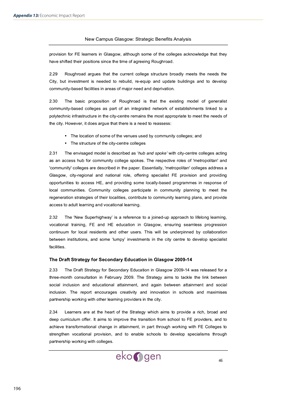
New Campus Glasgow: Strategic Benefits Analysis
46
provision for FE learners in Glasgow, although some of the colleges acknowledge that they
have shifted their positions since the time of agreeing Roughroad.
2.29 Roughroad argues that the current college structure broadly meets the needs the
City, but investment is needed to rebuild, re-equip and update buildings and to develop
community-based facilities in areas of major need and deprivation.
2.30 The basic proposition of Roughroad is that the existing model of generalist
community-based colleges as part of an integrated network of establishments linked to a
polytechnic infrastructure in the city-centre remains the most appropriate to meet the needs of
the city. However, it does argue that there is a need to reassess:
• The location of some of the venues used by community colleges; and
• The structure of the city-centre colleges
2.31 The envisaged model is described as 'hub and spoke' with city-centre colleges acting
as an access hub for community college spokes. The respective roles of 'metropolitan' and
'community' colleges are described in the paper. Essentially, 'metropolitan' colleges address a
Glasgow, city-regional and national role, offering specialist FE provision and providing
opportunities to access HE, and providing some locally-based programmes in response of
local communities. Community colleges participate in community planning to meet the
regeneration strategies of their localities, contribute to community learning plans, and provide
access to adult learning and vocational learning.
2.32 The 'New Superhighway' is a reference to a joined-up approach to lifelong learning,
vocational training, FE and HE education in Glasgow, ensuring seamless progression
continuum for local residents and other users. This will be underpinned by collaboration
between institutions, and some 'lumpy' investments in the city centre to develop specialist
facilities.
The Draft Strategy for Secondary Education in Glasgow 2009-14
2.33 The Draft Strategy for Secondary Education in Glasgow 2009-14 was released for a
three-month consultation in February 2009. The Strategy aims to tackle the link between
social inclusion and educational attainment, and again between attainment and social
inclusion. The report encourages creativity and innovation in schools and maximises
partnership working with other learning providers in the city.
2.34 Learners are at the heart of the Strategy which aims to provide a rich, broad and
deep curriculum offer. It aims to improve the transition from school to FE providers, and to
achieve transformational change in attainment, in part through working with FE Colleges to
strengthen vocational provision, and to enable schools to develop specialisms through
partnership working with colleges.
196
Appendix 13: Economic Impact Report